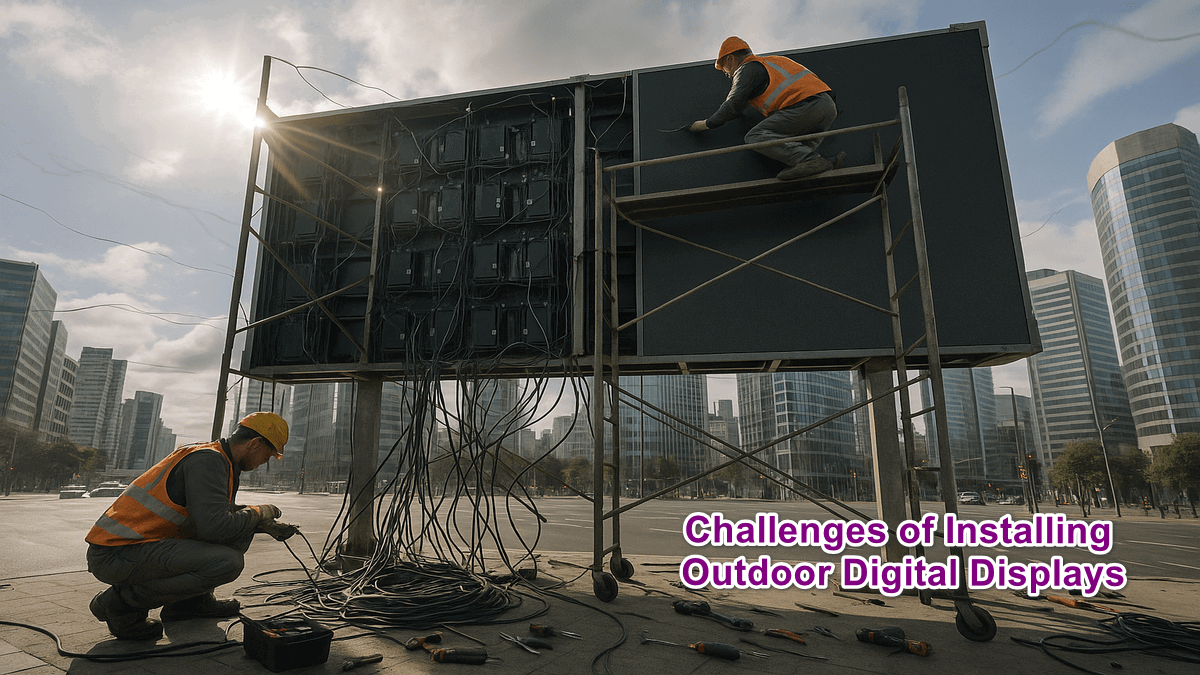In today’s fast-paced, tech-driven world, digital displays have become a cornerstone of modern communication. Outdoor digital signage, in particular, is transforming how businesses and public services engage with their audiences. From advertising in bustling city centers to delivering real-time information in transportation hubs, these dynamic screens are everywhere. However, the challenges of installing outdoor digital displays are numerous and complex. Understanding these challenges and how to overcome them is essential for anyone looking to implement a successful and sustainable signage solution.
Understanding the Core Challenges
Before delving into solutions, it’s vital to identify the core challenges of installing outdoor digital displays. These installations are subject to harsher conditions and more variables than their indoor counterparts, making their planning and execution significantly more demanding.
1. Weather and Environmental Conditions
Outdoor displays must endure a wide range of environmental factors including rain, snow, extreme temperatures, humidity, and even dust or sand. Without proper weatherproofing and environmental control mechanisms, displays can fail prematurely. In this context, digital signage maintenance becomes crucial. Regular inspections and proactive servicing can dramatically increase the lifespan of the equipment and minimize downtime.
 2. Power Supply and Connectivity
2. Power Supply and Connectivity
Establishing a reliable power source and stable internet connection in outdoor settings is not always straightforward. Installers must consider backup power options, surge protection, and network redundancy to ensure consistent performance.
3. Sunlight Readability
One of the most overlooked challenges of installing outdoor digital displays is ensuring screen visibility in direct sunlight. Glare and washed-out visuals can render content unreadable. High-brightness screens and anti-reflective coatings are essential to combat this issue.
4. Vandalism and Security
Publicly accessible displays are vulnerable to vandalism and theft. Strong enclosures, tamper-proof designs, and surveillance integration can help mitigate these risks.
5. Structural and Installation Concerns
Mounting a heavy display in an outdoor environment involves structural engineering. Factors such as wind load, wall strength, and local regulations must be taken into account. It’s also important to consider choosing the best size and type of Digital signage display based on the location’s visibility, audience distance, and purpose.
Strategic Solutions for Outdoor Display Challenges
Once the difficulties are identified, tailored strategies can be implemented to effectively manage or eliminate them. This is where outdoor digital signage solutions come into play, offering a toolkit of technologies and best practices for success.
 1. Weatherproof Design
1. Weatherproof Design
Selecting IP-rated enclosures and components designed specifically for outdoor use is the first step. These protect the internal electronics from moisture, dust, and extreme temperatures. Advanced climate control systems can regulate internal temperatures to prevent overheating or freezing.
2. Optimized Power and Network Infrastructure
Installing uninterrupted power supplies (UPS), surge protectors, and 4G/5G routers ensures that even during network outages or electrical issues, your display remains operational. Modern outdoor digital signage solutions also support remote monitoring, so issues can be diagnosed and resolved quickly.
3. High Brightness and Adaptive Display Technology
Look for displays that offer at least 2,500 nits of brightness and include sensors that adjust screen brightness based on ambient light. These features ensure readability across various lighting conditions.
4. Anti-Theft and Durability Features
Invest in tamper-proof enclosures and reinforced mounting hardware. Consider integrating the display into existing surveillance systems. These measures provide both physical protection and peace of mind.
5. Location-Specific Customization
Each location poses unique challenges of installing outdoor digital displays, so customization is key. Urban areas might require smaller displays due to space constraints, while highways or large open areas benefit from larger, high-impact screens. Consulting local building codes and working with experienced engineers is non-negotiable.
Importance of Professional Planning and Execution
While the allure of DIY installations may be strong, professional installation services are highly recommended. Certified installers bring valuable experience, ensuring compliance with regulations, safety standards, and technical requirements. Furthermore, professionals can assist in designing a Digital Signage to attract customers, tailoring content layout, screen positioning, and interactivity to maximize engagement.
Long-Term Sustainability and ROI
Outdoor signage is a long-term investment, and its ROI hinges on durability, effectiveness, and low maintenance costs. Partnering with vendors that provide warranties, support services, and outdoor digital signage solutions that are scalable ensures sustained value. It also allows for future upgrades, such as integrating interactive elements or data analytics.
Real-World Applications and Case Studies
Many cities around the world have successfully addressed the challenges of installing outdoor digital displays by leveraging smart technologies and strategic planning. For example, transport authorities use rugged, sun-readable displays to deliver real-time schedules, while retail chains use interactive kiosks in outdoor malls to increase customer engagement. This success hinges not only on hardware but also on clear project goals and community alignment.
Content Considerations
The effectiveness of outdoor displays depends as much on content as it does on hardware. Knowing what are digital signage displays and how they operate is only part of the equation. Creating dynamic, relevant, and eye-catching content that changes with time of day, season, or audience type is essential. Incorporating animations, localized messaging, and real-time data feeds can significantly boost viewer retention and action rates.
Conclusion
Overcoming the challenges of installing outdoor digital displays requires a multi-faceted approach. From technical engineering to creative design, every component must align to achieve a reliable and effective outcome. By leveraging high-quality hardware, expert installation, and smart outdoor digital signage solutions, businesses and public entities can create lasting digital touchpoints that inform, inspire, and interact with the world around them.
While there are many technical considerations, don’t underestimate the power of thoughtful design. Whether you’re placing a sign in a busy street or a quiet park, always consider the visual appeal, message clarity, and emotional impact of your content. After all, the goal isn’t just to display information — it’s to connect.




